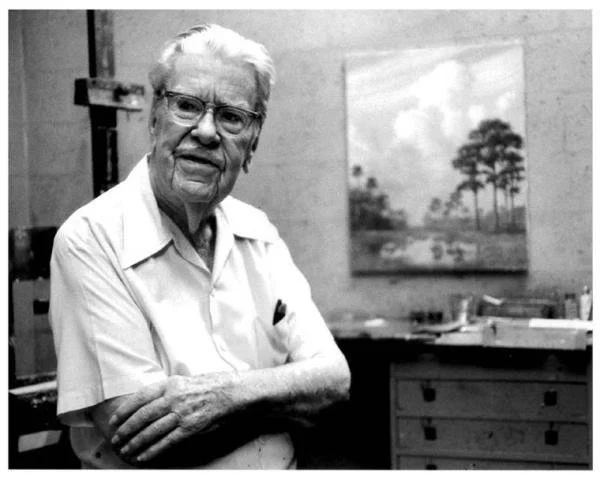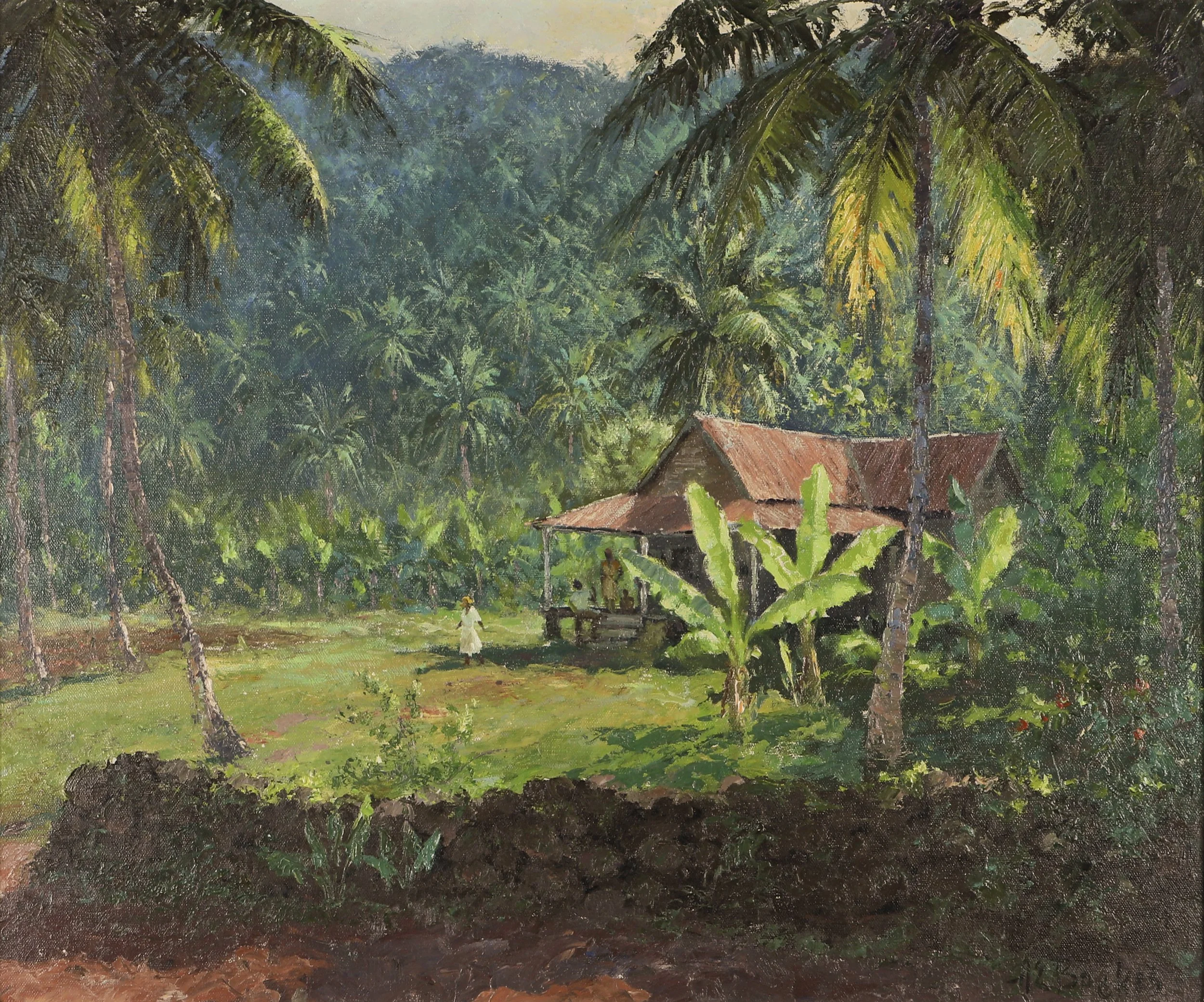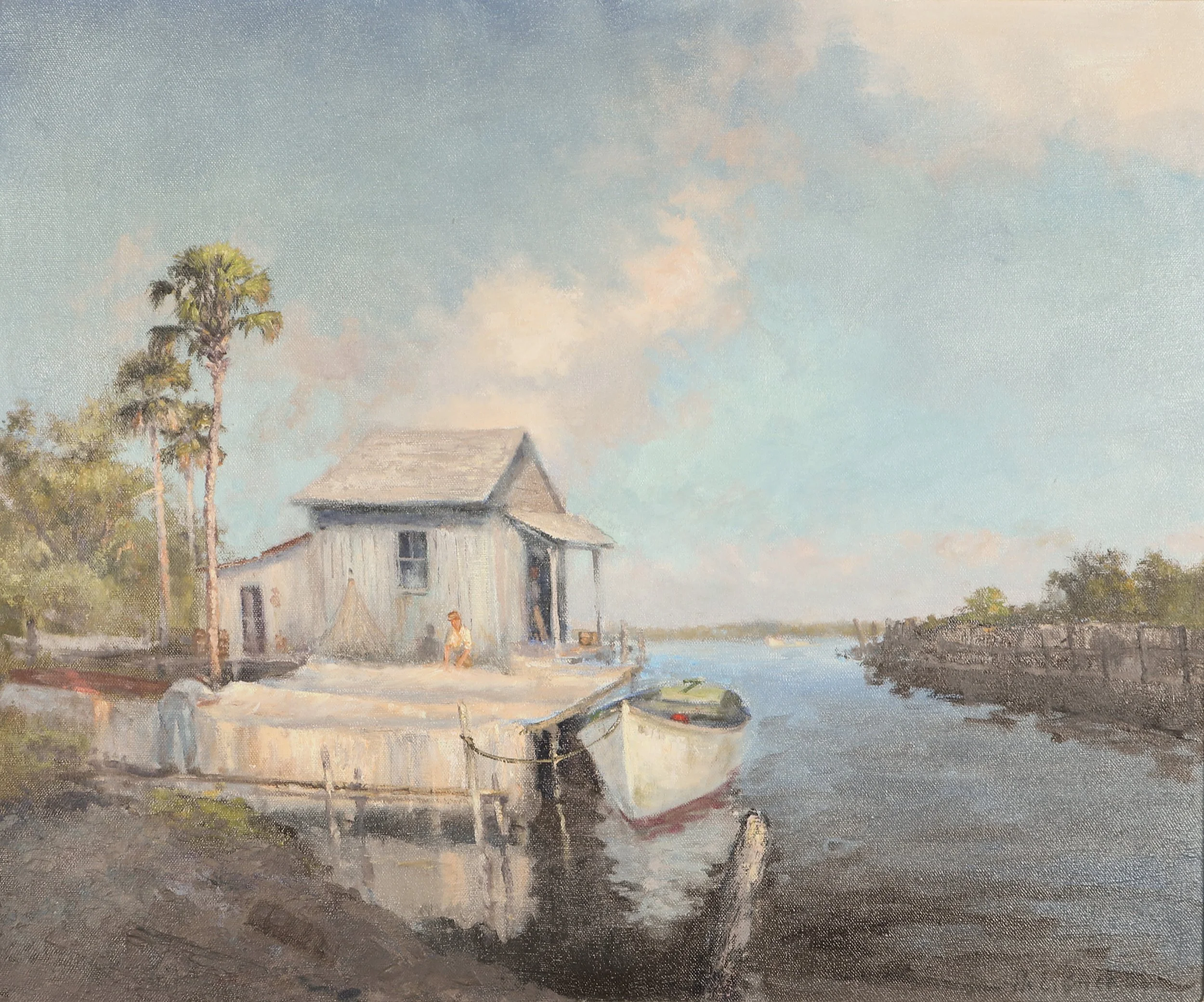Albert Ernest “Beanie” Backus (American, 1906-1990) was a Florida-based artist primarily known for his landscape paintings and his mentorship of young artists. Regarded as the “dean” of Florida landscape art, Backus’s work helped to create the national image of midcentury Florida. His mentorship to dozens of Florida artists resulted in his work being a major influence on the development of the Indian River School and the Florida Highwaymen. Backus’s masterful use of light and color and his naturalist’s eye for flora and fauna make his paintings not only romantic but also accurate depictions of the Florida landscape.
Backus was born in Fort Pierce, Florida in 1906. Backus began painting at a young age and was largely self taught. The extent of his formal training was two summers in 1924 and 1925 spent at Parson’s School of Design in New York City, paid for by a generous uncle. When Backus tried to pay him back, the uncle refused, telling him instead to “pass it on.” Early in his career Backus worked as a commercial artist, painting signs and murals for restaurants, backdrops for theater shows, and promotional material for developers. However, these jobs dried up with the Florida real estate bubble and the Great Depression, causing Backus to start selling his own paintings at art shows around the state. Throughout the 1930s, Backus gained statewide and national recognition in art fairs and competitions. In 1931 Backus had his first solo exhibition, sponsored by Dorothy Binney Palmer, one of his Fort Pierce patrons. In 1939 Backus was chosen to represent Florida in an exhibition of American art in San Francisco sponsored by the IBM Corporation.
Untitled (Three Tall Trees and Egrets in a Marsh)
In 1942 Backus enlisted in the US Navy, and served throughout WWII as a quartermaster on the USS Hermitage AP-54. The Hermitage’s commander was an amateur sculptor, and he and Backus quickly bonded over their shared love of art. Backus obtained permission to take shore leave and paint at many of the ports the ship visited, including in Casablanca, Le Havre, Marseille, Southampton, Belfast; Panama City and ports in the Canal Zone; Perth, Brisbane, Melbourne, Sydney in Australia, as well as Wellington, New Zealand; Mumbai, Honolulu, American Samoa, and Bora Bora in French Polynesia. These international perspectives allowed Backus to continue to develop his artist skills and his appetite for painting.
Following his return from the war, Backus enjoyed widespread commercial success. He was able to purchase his family’s old boat works on Moore’s Creek in Fort Pierce and transform it into a home and artist studio. Known as the Old Studio, it would be Backus’s home from 1946-1960. During this time Backus would create some of his most colorful and energetic paintings, beginning to use a palette knife more often than a brush to achieve a thick impasto effect. Remembering his uncle’s words to “pass it on,” he began to teach art lessons to local young people and to mentor aspiring artists. Among these early pupils were Alfred Hair (1941-1970) and Harold Newton (1934-1994), two young Black men who would go on to found the Florida Highwaymen.
Native Hut
In 1950 Backus married Patricia Hutchinson, and together they made their home a Bohemian refuge of art, debate, conversation, and music where anyone was welcome at any time. Sadly, Patricia died just five years later in 1955. Distraught at the death of his wife, Backus fled to the Caribbean, visiting Jamaica for the first time in 1956 and quickly purchasing land and building a studio retreat there in 1958. Jamaica’s lush and verdant landscape would inspire him to balance his previously cooler color palette with complementary warm hues, making his paintings far more striking. Additionally, his paintings following his visits to Jamaica feature more figures than those done in Florida.
In 1960 Backus moved to his “New Studio” on 122 Avenue C in Fort Pierce, marking his metamorphosis from emerging to established artist. The style of his work became more refined and detail-oriented, characterized by a return to brushwork and the creation of more polished surfaces. His subject matter shifted as well, featuring more savannahs, glades, rivers, and backcountry scenes of rural Florida. He also hired a studio manager and several assistants, including Paul Abstein (1952-2004) and Don D. Brown (1947-2024). However some core practices from the Old Studio remained the same. He continued to mentor younger artists, teach classes, and kept his welcoming open door policy. Backus consistently prioritized making paintings for local charities to use in fundraisers, and he helped found the Fort Pierce Art Gallery–renamed the A.E. Backus Museum and Gallery following his death–and served as its first art director. Throughout Backus’s career, giving back to his community and passing on what he had learned were pillars of his practice.
Untitled (Waterside Grove of Yellow and Violet Blooming Trees)
Backus’s later years saw him achieve the highest honors of his career, being increasingly recognized as one of Florida’s most significant artists and an important figure in racial justice and reconciliation. He began to be referred to as “Florida’s painter laureate,” and by 1968 was declared the “Dean of Florida’s landscape painters.” In the 1960s, he was one of the community leaders appointed to Fort Pierce’s first Bi-Racial Commission. In 1979 Governor Bob Graham declared him to be the “best-known representational artist in the state” at a ceremony in Tallahassee. And in 1980, Florida Atlantic University conferred an honorary degree of Doctor of Humane Letters. His paintings are included in private and public collections all over the United States, including in the Lyndon B. Johnson Memorial Library and the personal collection of former US Senator Bob Graham. After suffering a series of heart attacks, Backus died in 1990.
Backus’s artistic legacy is irrevocably tied to his community. His sister Laura Nottage once remarked that “Bean always wanted to be known as a humanitarian, rather than for his art.” While he was not the first to paint the Florida landscape, painters of the 19th and early 20th Centuries were previously established artists whose depictions of Florida, while beautiful, were fundamentally from a visitor’s eyes. Backus’s intimate knowledge of the life, character, and communities of Florida gave to his paintings a depth heretofore undepicted. Backus was able to combine the scientific accuracy captured by naturalist painters and the emotional character captured by romantic painters with that undefineable quality of that which makes a community and a home.
Cedar Key
His love for his community overflowed his own practice and into the lives of those around him. Through his tireless mentorship of young artists, Backus inspired a whole generation. Two of his most well known legacies are the Indian River School–a school of painting made up of his direct pupils–and the Highwaymen–a group of twenty six African American landscape painters founded by Alfred Hair, one of Backus’s early pupils. Twenty–eight artists in the Florida Artists Hall of Fame can trace their origins to Backus, and Backus himself was posthumously inducted in 1993. Backus’s paintings captivated and inspired so many because he painted his home, with all of the care and attention it deserves.




